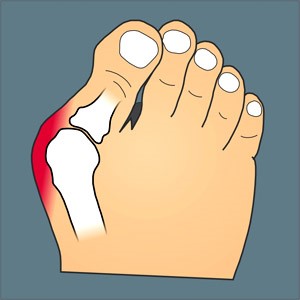American Women Getting Bunions from Wearing Wrong Shoe Sizes
Monday, 02 February 2015 00:00 According to a study done by the American Orthopaedic Foot and Ankle Society, 88% of women living in the United States don’t wear shoes that are large enough for their feet. 55% of U.S. women also have bunions, which often develop in people who wear ill-fitting shoes often.
According to a study done by the American Orthopaedic Foot and Ankle Society, 88% of women living in the United States don’t wear shoes that are large enough for their feet. 55% of U.S. women also have bunions, which often develop in people who wear ill-fitting shoes often.
People’s feet change size as they get older, but they rarely take the time to get them measured. Now with the increased popularity of online shoe shopping, more and more women are buying footwear without trying them on first, which often causes them to get the wrong size. Then when they wear them, they become prone to developing corns, bunions, hammertoes, and more.
Bunions are extremely painful and eventually require surgery in some cases. If your feet are plagued by this irritating condition, consult with Dr. Steven Schwartz of Pennsylvania. Dr. Schwartz can teach you about how bunions form and help you decide how you would like to proceed with treatment.
What is a Bunion?
A bunion is an enlargement of the base joint of the toe that connects to the foot. The enlargement is formed of swollen tissue or boney growth. This swelling is caused by a shifting of the bones in the big toe inward, impacting the other toes of the foot. The area around the base of the big toe may become inflamed, red, and/or painful.
Formation
Genetics – people who are susceptible to bunions are often genetically predisposed.
Stress on the feet – wearing improperly fitting shoes or running and walking with improper form may cause stress on the feet. Wearing high heeled shoes puts the weight from the body onto the toes, causing further stress and bone displacement.
Diagnosis
A podiatrist who specializes in foot structure and bio-mechanics will be able to diagnose bunions.
Blood Tests - testing the blood for gout or arthritic conditions can help identify the causes.
Radiological Exam – a podiatrist will request an exam to identify the bunion by taking a look at the bone structure. If the x-ray shows an enlargement of the joint near the base of the toe, shifting toward the smaller toes, this usually indicates a bunion.
For more information about Bunions, follow the link below.
If you have any questions, contact one of our offices located in Chambersburg and Mcconnellsburg, PA. We offer the newest diagnostic and treatment technologies for all your foot care needs.
Read more about Bunions

